�
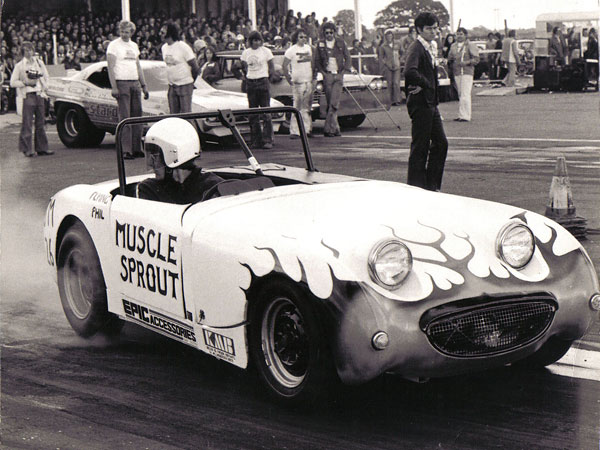 �
�
Philip Herrick's Austin-Healey Sprite Race Cars
�The Story of Sprite "VNR 448"
� as published in BritishV8 Magazine, Volume XVI Issue 2, October 2008�� Owner: Philip Herrick
� � City: Melchbourne, Bedfordshire, England
� Model: 1960 Austin Healey Sprite Mk 1
� Current engine: Rover 3.5L V8
� Conversion performed by: owner�
�
�
In 1973, I purchased a wrecked 1960 Sprite as a "write-off". It had been owned and modified �
by a friend of mine, who sold it... and it was crashed three weeks later! I bought it, �
dismantled it, straightened it, and re-built it as a drag racing car. It had a full-race �
970cc engine, it weighed 1170lbs, and it achieved a best standing-start quarter mile time�
of 15.1 seconds (at 90 mph). �
�
Named "Muscle Sprout", my 1960 Sprite was the RAC (Royal Automobile Club) Junior Modified �
class champion in 1975.�
�
�
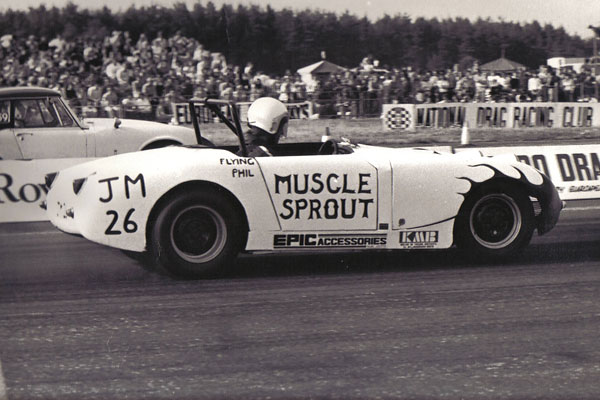
�
Royal Automobile Club "Junior Modified" Class Champion (circa 1975, Blackbushe Dragstrip)
�
�
Encouraged by this success, I decided to move up and compete in the "Competition Altered" �
class. The second version of Muscle Sprout featured a tube chassis and a one-piece, �
tilt-up "funny car" body with the driver position centered. In this configuration, �
the car was powered by an Alfa Romeo 2.6L straight-six engine. It was much faster of �
course, running 13.1 second quarter miles (at 110 mph).�
�
�
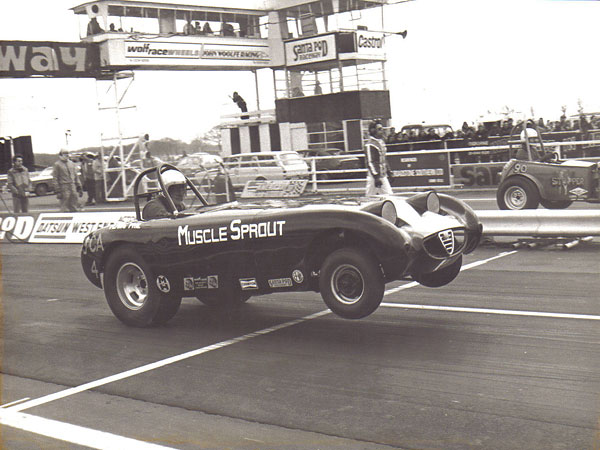
�
The Second Generation of Muscle Sprout, at England's famous Santa Pod Raceway
�
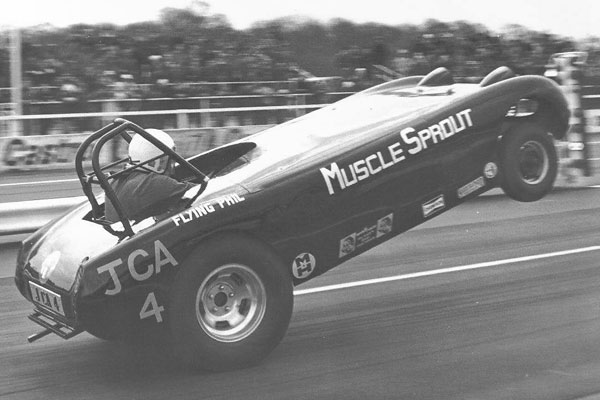
�
�
Later, a change to Rover V8 power brought my best quarter-mile time down to 11.6 seconds (at 125mph). �
�
�
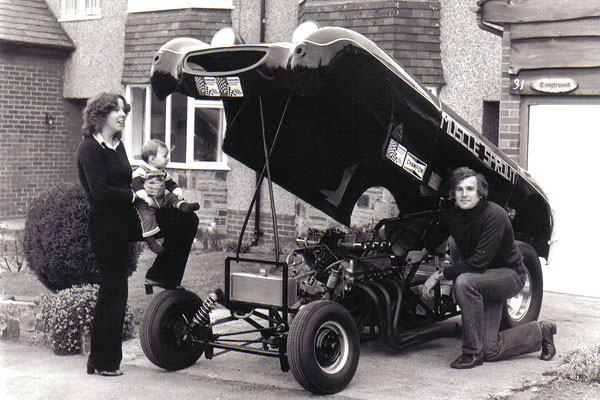
�
Newly installed Rover V8 engine, with four Weber DCOE two-barrel, side-draft carburetors.
�
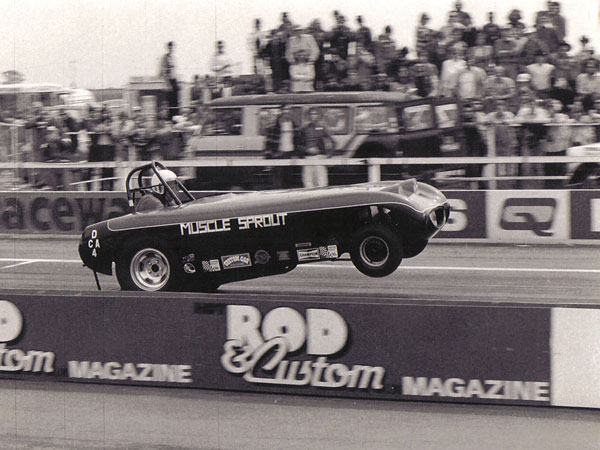
�
Philip Herrick's "Muscle Sprout" (circa 1981)
�
�
Muscle Sprout was re-bodied to create "Vicious Trait". We hoped at the time that the TR8 �
body would help us attract sponsorship. (The body was actually pieced together from steel �
TR7 panels from a wrecker's yard, and it was thus obviously heavier than the Sprite body.) �
We didn't get the new body constructed quickly enough! By the time we were ready to race �
Vicious Trait, Triumph TR7/8 production was discontinued. The possibility of Triumph �
sponsorship evaporated.�
�
�
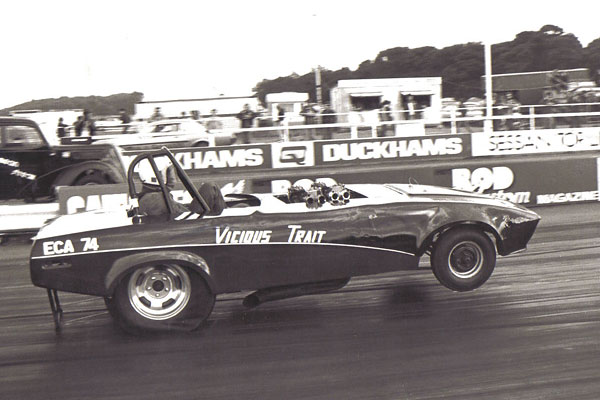
�
This is what Vicious Trait looked like at one of her first outings to Santa Pod Raceway.
�
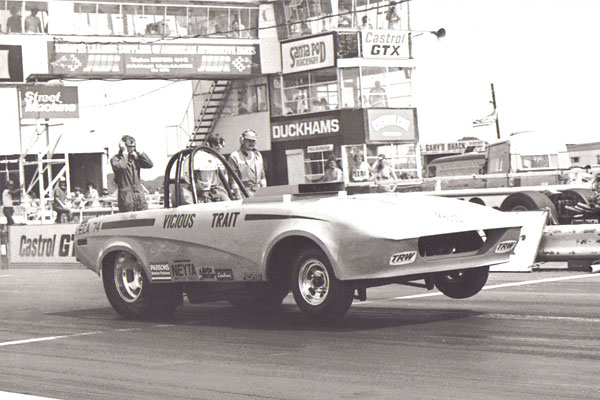
�
An updated version of "Vicious Trait". (Note the new hood scoop, paint, front axle, and wheels.)
�
�
However, by 1985 I wanted a fresh challenge and decided to build a Rover powered street �
legal Sprite, so I put Vicious Trait up for sale. However, I kept many of the spare �
parts I'd accumulated over the years. Most importantly, I kept the Muscle Sprout's fiberglass �
body - and the registration plate that came with my 1960 Sprite back in 1973! I'm still �
using it to this day. �
�
In April of that year I purchased a badly bent, written-off Midget 1500. This was stripped, �
and the floorpan was straightened using a "Porta-Power" ram, various blocks, struts and �
the concrete roof of my garage! Attention then moved to the front and how to fit the �
V8 engine and gearbox. I purchased a second-hand Rover 4-speed manual box as it was �
smaller than the five-speed, and cheaper!�
�
�
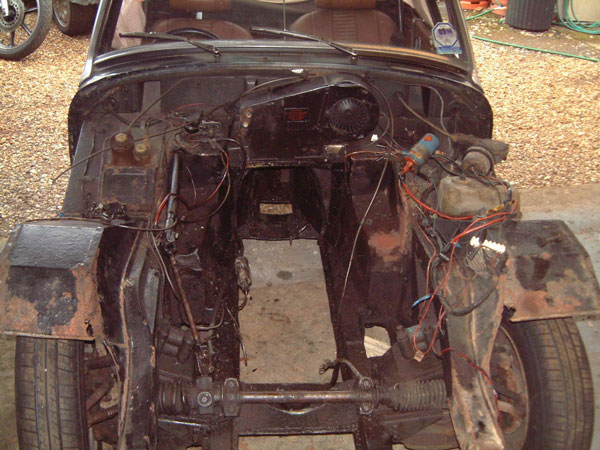
�
�
Enjoying this article? Our magazine is funded through the generous support of readers like you!
�
To contribute to our operating budget, please click here and follow the instructions.
�
(Suggested contribution is twenty bucks per year. Feel free to give more!)�
�
�
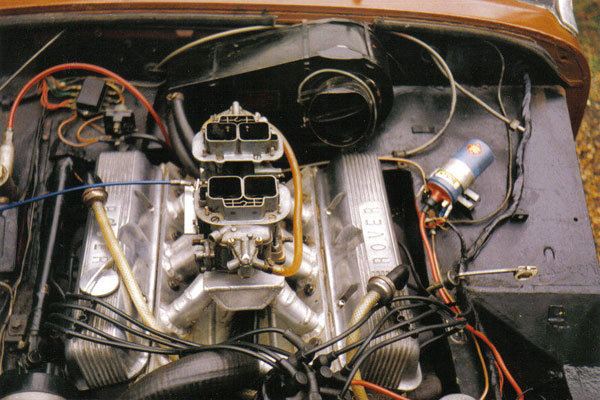
�
Rover V8 with two 34 DGAS Weber carburetors.
�
�
The main problem areas were the width across the foot well "boxes" at the top and the �
bellhousing / gearbox size. After careful measuring and positioning of a bare engine �
block, I cut out the top front corners of the footwell boxes, inverted them, and welded �
them back into position. The under heater ducting was cut out and the heater positioned �
against the bulkhead where the battery was originally positioned. The interior heater �
flaps were the moved to the bulkhead above the transmission tunnel. �
�
The transmission tunnel was cut out all the way back to the handbrake, and part of the �
bulkhead was removed too. It was raised approx 2" using sheet steel strips and widened �
to fit around the Rover bellhousing. The box section in the tunnel had to be removed. �
(A roll cage would be added to restore lateral strength.)�
�
With the exhaust manifold in position, the steering column had to have its angle �
changed to run above the exhaust manifold. As the 1500 had a collapsible steering �
column, it was easy to shorten by shearing the plastic pin and re-pinning it through �
a newly drilled hole. The outer tube was also shortened, and the front flange was �
bolted to the bumper support section that runs to the front of the car. A short �
steering column section with two universal joints (Triumph 1500, I think) was sourced �
from a scrapyard to run the steering down to the standard rack, which was rotated �
slightly to suit. Fortunately, the splined sections matched!�
�
�
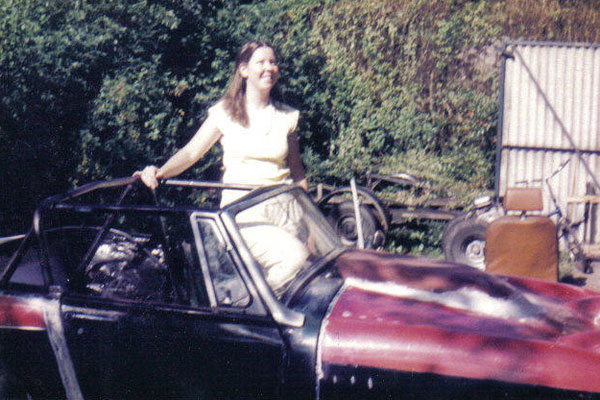
�
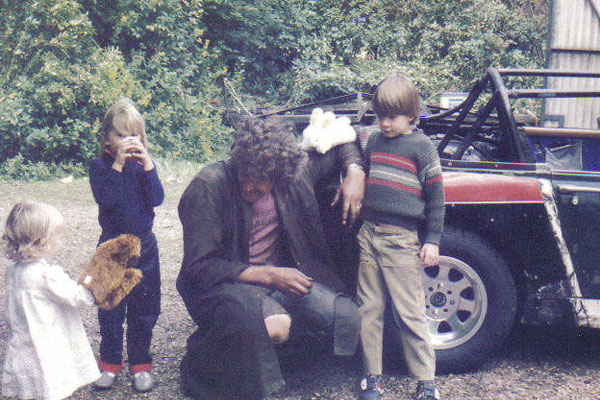
�
�
A six-point tubular roll cage was fabricated and welded into the body shell. This �
was braced against the dashboard section at the front and down to the rear spring �
mounting channel section in the boot. (Note: the Midget 1500 bodyshell has reinforced �
sections front and rear to suit the Federally-mandated "rubber bumpers".)�
�
A remote oil filter system was plumbed-in using an adapted oil filter top, hydraulic �
hose and a hydraulic remote oil filter which is clamped under the radiator onto the �
steering rack.�
�
�
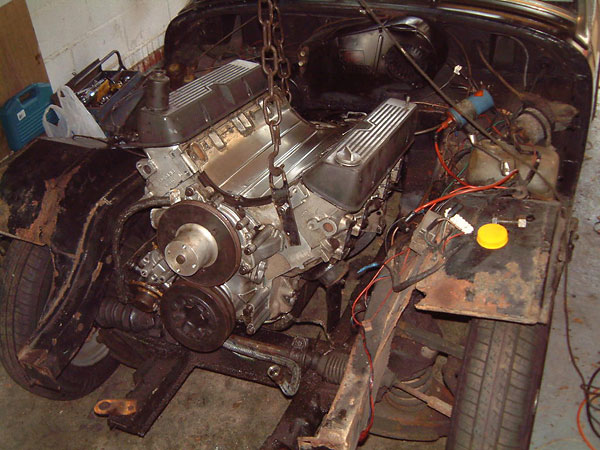
�
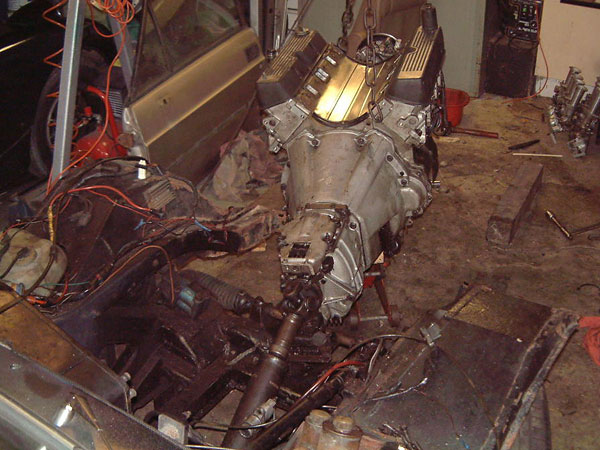
�
A Rover 4-speed manual transmission was selected because they're very compact!
�
�
As mentioned earlier, the Rover 4-speed gearbox was used, but the gear stick was too �
far back. After a close look, I realized that the gear stick could go directly into �
the selector rods by just drilling and tapping for the three holes of the collar that �
holds the gearstick. These are around the square hole in the aluminum gearchange �
extension housing. It popped out when going for reverse but a bit of welding and �
shaping, to extend the ball end, cured that. �
�
The Midget rear axle was replaced by a stronger one from a Ford Anglia 105E. (This type �
of axle was also under Ford Escorts, but the Anglia version has a slightly narrower �
track dimension). I selected the lowest ratio I could easily find: 3.54:1. Ford u-bolts �
were used with the modified Midget spring mounting pads and existing lever arm shock �
absorbers. �
�
A hybrid propeller shaft was fabricated with a Rover front section and Ford rear �
section. Similarly the Midget handbrake cable front was linked to the Ford handbrake �
cable rear with a brazed splice. �
�
The Muscle Sprout's fiberglass "frogeye" bonnet needed to be trimmed down, and a "power �
bulge" needed to be added over the carburetors. The bulge was actually a section from a �
fiberglass L88 Corvette bonnet! I molded it in to cover the standard Rover twin 1.75" �
SU carburetors. At the back, the Muscle Sprout's fiberglass rear wings were fitted as well. �
�
Tip: To prevent cracking when shutting the doors, it is essential to keep as much of �
the rear door pillar as possible and overlap the fiberglass panel. The bonnet was �
blended into the steel top section to retain the later style hood fitting. The boot �
lid and surround were retained for practicality and increased rigidity. �
�
I initially kept the Midget 1500 springs (front and rear), but when the car was �
finished it sat too high because it now weighed less than the stock! (The Triumph �
1500cc engine has a cast iron block and the "rubber bumpers" each hide a steel girder!) �
To correct for this, I used the shorter Midget 1275 front coil springs and less-curved �
1275 rear leaf springs. A pair of anti-windup "slapper bars" were fitted under the �
front of the leaf springs. The standard lever arm shocks were retained as it was a �
road car not a track special.�
�
I retained the standard front disc brakes, except with new discs and pads of course! �
The Anglia rear axle had larger drum brakes than the Midget. As the car is lighter than �
an Anglia, from any given speed the brakes are doing less work. Unless I drive like a �
lunatic and hammer the brakes, they're fine for road use. The rubber flexible brake �
lines have been replaced by Aeroquip fittings.�
�
I discovered that a local factory machined "Falcon" alloy wheels and so I purchased a �
set of five 13" by 5.5" Sprite wheels. I had three of them drilled for both MG and Ford �
lug patterns. Some 185x70 tires were then fitted all round.�
�
Just as I was finishing the car I read that there was to be a new drag racing competition �
for road legal Rover powered street cars... so it ended up racing in the summer and being �
used on the road in the winter!�
�
�
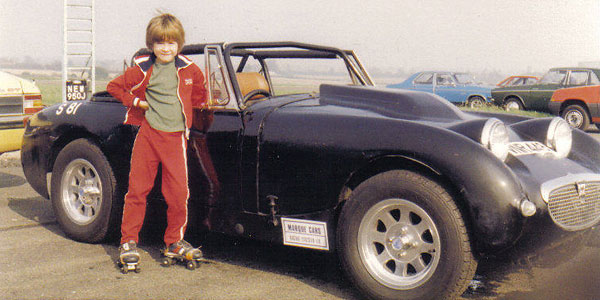
�
The very first outing of the "Super Sprite V8", circa 1985.
�
It was a long day: "I tried a very short oil filter in the stock position, but it rubbed against
�
the chassis, punctured, and lost all the oil - hence the change to the remote filter!"
�
�
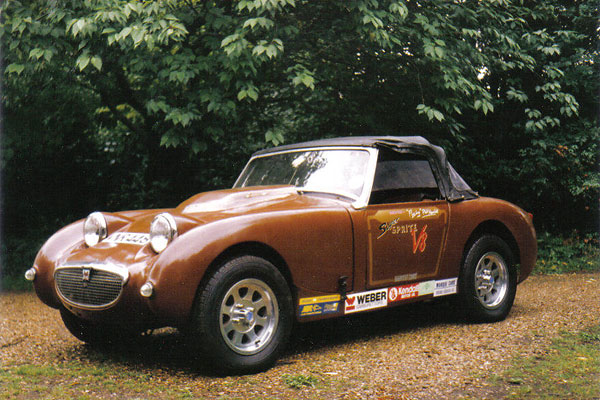
�
Back for 1986 with a new paint job! Note: the windscreen was installed and removed as required.
�
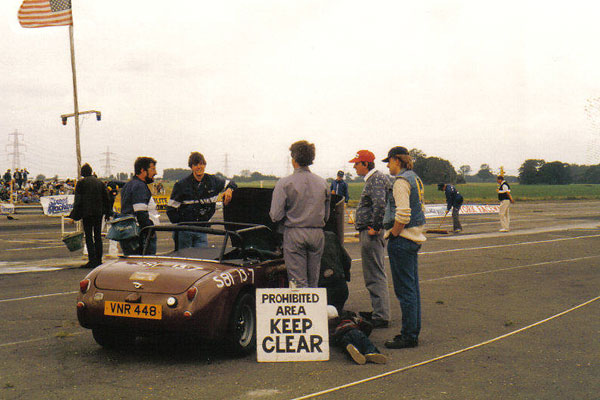
�
�
For racing, I fabricated an aluminum inlet manifold to take 2 x 34 DGAS Weber downdraft �
carburetors (as used on 3L Ford Capri engines). I then made up a pair of tubular exhaust �
headers with 4-into-1 collectors. The camshaft and followers were replaced with a Crane �
H234 hydraulic race-cam set-up.�
�
I removed the windscreen, hood assembly and the passenger seat. The doors were replaced �
by stripped ones, with no glass and fittings. The differential was changed for a 3.9:1 �
ratio "locked" unit. Wider rear wheels and tires, narrower front wheels and tires �
completed the transformation.�
�
With this arrangement the car achieved a best quarter mile time of 12.9 seconds at 113mph, �
and finished runner up in the 1987 Street Machine Rover V8 Street Rover Championship.�
�
Since then the car has been used occasionally on the road and this year I finally achieved �
a long held ambition and fabricated another inlet system. This uses 4 x 34 DHLA Dellorto �
downdraft carburetors (S/H ex Alfa 1.5 Sud/Sprint engines) on a pair of aluminum �
manifolds with 1.5" spun alloy ram pipes - now I need a bigger bulge in my bonnet!�
�
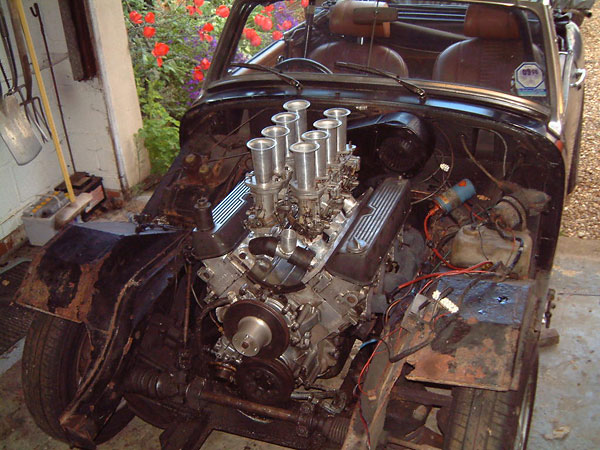
�
4 x 34 DHLA Dellorto downdraft carburetors (S/H ex Alfa 1.5 Sud/Sprint engines)
�
Current Configuration
�| Engine: | �Rover 215ci (3523cc) V8. Crane H234 hydraulic race cam and Crane followers.�
Stock Lucas distributor, with a Lumenition Electronic Ignition module �
in lieu of breaker points. | �
| Induction: | �standard Rover twin 1.75" SU or custom 2 x 34 DGAS Weber, or custom �
4 x 34DHLA Dellorto Carburettors... | �
| Cooling: | �uprated (diesel specification) BLMC Morris Marina radiator. | �
| Exhaust: | �either full 2 x 4-into-1 tubular headers for racing, or stock cast �
iron Rover P5B V8 Exhaust manifolds with custom downpipes. | �
| Transmission: | �standard Rover 4-speed manual transmission, with direct top gear.�
Standard Rover V8 diaphragm clutch. Custom driveshaft created from a �
Rover V8 front section welded to a Ford Anglia 105E rear section. | �
| Rear Axle: | �stock Ford Anglia 105E with a (stock) 3.54:1 ratio differential �
(for road use) and a locked 3.7:1 ratio gear set (for race use). �
Anglia van half shafts. | �
| Front Suspension: | �standard 1275 Sprite/Midget coils springs and lever arm shock absorbers. | �
| Rear Suspension: | �standard 1275 Sprite/Midget leaf springs and lever arm shock absorbers. | �
| Brakes: | �stock MG Midget front discs and pads. Stock Ford Anglia Rear Drums and shoes. | �
| Wheels/Tires: | �(road) Falcon 13x5.5 alloy wheels with 185x70 tires. � (racing) 13x 3.5" or 4.5" front wheels with 145x70 tires. Rear 13x6 wheels with 205x65 tires. | �
| Weight: | �~1700 pounds. | �
| Electrical: | �standard Smiths gauges, except the tachometer has been modified for V8 use. | �
| Other Mods: | �full 6-point roll cage (welded in place). Fiberglass "Frogeye" style �
forward-hinged bonnet. Fiberglass frogeye rear wings grafted around the �
Midget Boot section. Transmission tunnel raised and widened. Engine bay�
and footwells modified. | �
| Performance: | �in race trim, standing start quarter miles in 12.9s at 113mph. | �
| Date Completed: | �
on the road (and raced) since 1985, but not yet "completed"!�
(It's been driven approximately 12000 miles since 1985.) | �
| Comments: | �
the Midget 1500 chassis has reinforcements that make it stronger than earlier �
chassis. It also has a dropped section behind the steering rack which makes it �
easier to fit longer engines and clear the front pulley.�
� The rear axle started to rotate on the U-bolts, which caused rapid failure of � the rear universal joint. I welded a reinforcement of the axle spring pads � to prevent that from happening again. "Slapper bars" under the front of the � rear springs prevent spring "wind-up" on acceleration. | �
�
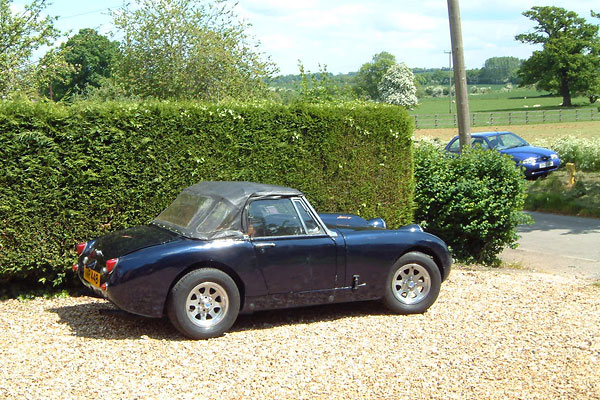
�
It's a Midget 1500 bodyshell, but it's wearing Sprite Mk.1 style fiberglass bonnet and quarterpanels.
�
(This photograph was taken in May 2008 and it shows the current paint color, which is navy blue.)
�

